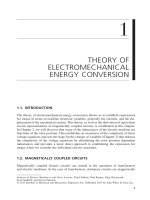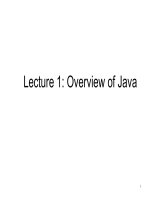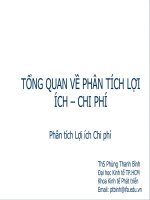- Trang chủ >>
- Khoa Học Tự Nhiên >>
- Vật lý
lecture 1 quantization of energy
Bạn đang xem bản rút gọn của tài liệu. Xem và tải ngay bản đầy đủ của tài liệu tại đây (754.96 KB, 4 trang )
Lecture 1 – Quantization of energy
Quantization of energy
Energies are discrete (“quantized”) and not continuous.
This quantization principle cannot be derived; it should
be accepted as physical reality.
Historical developments in physics are surveyed that led
to this important discovery. The details of each
experiment or its analysis are not so important, but the
conclusion is important.
Lecture 1:
Quantization of Energy
TTT
Quantum Chemistry
Historical Development
Applying quantum mechanics (QM) in chemistry
QM the laws governing behavior of
subatomic, atomic and molecular species
Chemistry - consequence of the laws of QM
QM understanding chemistry in fundamental
level of electrons, atoms, and molecules
Quite mathematical and abstract
1890’s: Classical physics – well developed
• Classical mechanics -- Newtonian
• Maxwell’s theory of electricity, magnetism, and
electromagnetic radiation
• Thermodynamics
• Kinetic theory of gases
TTT
Lecture 1/ 3
TTT
Beginnings of the Quantum Revolution (1890’s
to 1920’s)
Quantization of energy
Experiments could not be explained by Classical Physics
• Blackbody radiation
• Photoelectron effect
• Atomic spectra
• Sub-atomic particles (electron)
Classical mechanics: Any real value of energy is
allowed. Energy can be continuously varied.
Quantum mechanics: Not all values of energy are
allowed. Energy is discrete (quantized).
TTT
Lecture 1/ 5
TTT
Lecture 1/ 2
Lecture 1/ 4
Lecture 1/ 6
1
Lecture 1 – Quantization of energy
Black-body radiation
Black-body radiation
A heated piece of metal emits
light.
As the temperature becomes
higher, the color of the emitted
light shifts from red to white to
blue.
How can physics explain this
effect?
A “Black Body” is a box with a
small hole in it.
If hot, it is filled with light, which
escapes the hole.
The nature of the light depends
only on temperature, not material.
TTT
TTT
Lecture 1/ 7
Light: electromagnetic oscillation
Lecture 1/ 8
Black-body radiation
Wavelength (λ) and frequency (ν) of light are inversely
proportional: c = νλ (c is the speed of light).
Longer wave length
Radiowave
Microwave
IR
Visible
UV
X-ray
γ-ray
>30 cm
30 cm – 3
mm
33–13000
cm–1
700–400
nm
3.1–124
eV
100 eV –
100 keV
>100 keV
Nuclear
spin
Rotation
Vibration
Electronic
Electronic
Core
electronic
Nuclear
What is “temperature”? – the kinetic energy (translation,
rotation, vibrations, etc.) per particle in a matter.
Light of frequency v can be viewed as an oscillating
spring and has a temperature.
Equipartition principle: Heat flows from high to low
temperature area; in equilibrium, each oscillator has the
same thermal energy kBT (kB is the Boltzmann constant).
Higher frequency
TTT
Lecture 1/ 9
TTT
Lecture 1/ 10
Black-body radiation: classical
Black-body radiation: experiment
With increasing
temperature, the
intensity of light
increases and the
frequency of light at
peak intensity also
increases.
Intensity curves are
distorted bell-shaped
and always bound.
Classical mechanics leads to
the Rayleigh-Jeans law.
As per this law, the number of
oscillators with frequency v is
v 2 and each oscillator has
kBT energy. Hence I ~ kBTv 2
(unbounded at high v).
Ultraviolet catastrophe!
Intensity I
Intensity I
High T
Low T
Experimental
Red
Frequency v
Violet
Red
TTT
Lecture 1/ 11
Frequency v
Violet
TTT
Lecture 1/ 12
2
Lecture 1 – Quantization of energy
Black-body radiation: quantum
Black-body radiation: quantum
kBT
hν
Planck could explain the bound
experimental curve by
postulating that the energy of
each electromagnetic oscillator
is limited to discrete values
(quantized).
E = nhν (n = 0,1,2,…).
h is Planck’s constant.
hν hν hν hν hν hν hν hν hν hν
hν
0
hν
hν
hν
Intensity I
ν
Correct curve
I ~ v 2 × hv / (ehv/kBT−1)
Effective # of oscillators
1 / (ehv/kBT−1)
Energy of an oscillator
hv / (ehv/kBT−1)
Max Planck
A public image from Wikipedia
TTT
Frequency v
Lecture 1/ 13
Planck’s constant h
TTT
∞
Thermal energy kBT
ceases to be able to
afford even a single
quantum of
electromagnetic
oscillator with high
frequency v; the
effective number of
oscillators
decreases with v.
Lecture 1/ 14
Heat capacities
E = nhν (n = 0,1,2,…)
h = 6.63 x 10–34 J s. (J is the units of energy and is equal
to Nm). The frequency has the units s–1.
Note how small h is in the macroscopic units (such as J
s). This is why quantization of energy is hardly
noticeable and classical mechanics works so well at
macro scale.
In the limit h → 0, E becomes continuous and an
arbitrary real value of E is allowed. This is the classical
limit.
Heat capacity is the amount of
energy needed to heat a
substance by 1 K.
It is the derivative of energy with
respect to temperature:
C=
dE
dT
Lavoisier’s calorimeter
A public image from Wikipedia
TTT
Lecture 1/ 15
TTT
Heat capacities: classical
Heat capacities: experiment
dE
= 3N A kB = 3R
dT
TTT
R
Dulong-Petit law
Heat capacity C
The classical Dulong-Petit law: the heat capacity of a
monatomic solid is 3R irrespective of temperature or
atomic identity (R is the gas constant, R = NA kB).
There are NA (Avogadro’s number of) atoms in a mole of
a monatomic solid. Each acts as a three-way oscillator
(oscillates in x, y, and z directions independently) and a
reservoir of heat.
According to the equipartition principle, each oscillator
is entitled to kBT of thermal energy.
E = 3N A kBT Þ C =
Lecture 1/ 16
The Dulong-Petit law
holds at high
temperatures.
At low temperatures, it
does not; Experimental
heat capacity tends to
zero at T = 0.
Temperature T
Lecture 1/ 17
TTT
Lecture 1/ 18
3
Lecture 1 – Quantization of energy
Heat capacities: quantum
Heat capacities: quantum
This deviation was explained and corrected by
Einstein using Planck’s (then) hypothesis.
At low T, the thermal energy kBT ceases to be able to
afford one quantum of oscillator’s energy hν.
Heat capacity C
kBT
hv
hv
hv
kBT
hv
hv
kBT
hv
hv
Debye
Einstein
…
hv
hv
hv
hv
Einstein assumed only one
frequency of oscillation.
Debye used a more
realistic distribution of
frequencies (proportional
to v 2), better agreement
was obtained with
experiment.
R
hv
Temperature T
Low T
High T
TTT
Lecture 1/ 19
Continuous vs. quantized
TTT
Lecture 1/ 20
Atomic & molecular spectra
In both cases (black body radiation and heat capacity), the effect
of quantization of energy manifests itself macroscopically when a
single quantum of energy is comparable with the thermal energy:
Emission spectrum of the iron atom
hν ≈ kBT
kBT
kBT
A public image from Wikipedia
kBT
kBT
Colors of matter originate from the light emitted or
absorbed by constituent atoms and molecules.
The frequencies of light emitted or absorbed are found
to be discrete.
Higher frequencies
or lower temperatures
TTT
Lecture 1/ 21
TTT
Lecture 1/ 22
Summary
Atomic & molecular spectra
This immediately indicates that
atoms and molecules exist in
states with discrete energies (E1,
E2, …).
When light is emitted or absorbed,
the atom or molecule jumps from
one state to another and the
energy difference (hv = En – Em) is
supplied by light or used to
generate light.
TTT
Lecture 1/ 23
Energies of stable atoms, molecules, electromagnetic
radiation, and vibrations of atoms in a solid, etc. are
discrete (quantized) and are not continuous.
Some macroscopic phenomena, such as red color of hot
metals, heat capacity of solids at a low temperature, and
colors of matter are all due to quantum effects.
Quantized nature of energy cannot be derived. We must
simply accept it.
TTT
Lecture 1/ 24
4









